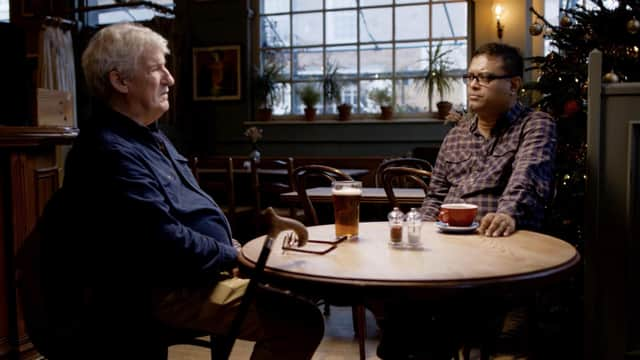6 lesser-known signs of Parkinson's as Jeremy Paxman opens up about his condition


“The first thing I knew was when somebody was sitting me on a bench.
"I’d fallen over and I made a terrible mess of my face,” the 72-year-old says in Paxman: Putting Up With Parkinson’s, which aired earlier this week on ITV.
Advertisement
Hide AdAdvertisement
Hide AdHe continues: “When I was in A&E, a doctor walked in and said, ‘I think you’ve got Parkinson’s.’ And it turned out that he had been watching University Challenge and had noticed that my face had acquired what’s known as the Parkinson Mask. I wasn’t as effusive and exuberant as normal. I had no idea.”


In the documentary, Paxman, who announced in August he was departing the legendary quiz show after 29 years, chats to The Chase’s Paul Sinha, who also has Parkinson’s, about his experience with the condition – which usually starts to show after the age of 50.
“It’s a much more complicated disease than people give it credit for, isn’t it? Because everyone associates it with the tremors,” Sinha says.
“But at the moment the tremors are not really part of my diagnosis.
"For me, it’s the tightness and slowness of movement.”
Advertisement
Hide AdAdvertisement
Hide AdIn the one-off, hour-long special, Jeremy allowed cameras into his life for the first time, as he reflects on how Parkinson’s has impacted on him, physically and mentally.
He talked to experts who are at the leading edge of research, including observing a brain dissection, and also speaks to other high-profile people living with the degenerative disease.
He meets Jane Asher, the president of Parkinson’s UK, attends an English National Ballet therapy dance class – that should be interesting – and learns how to play bowls.
Statistics show one in 37 people in the UK will be diagnosed in their lifetime and, proving there’s still very much life in the old journalist dog yet, Jeremy investigates and busts some of the myths surrounding Parkinson’s disease.
Advertisement
Hide AdAdvertisement
Hide AdResearchers don’t yet know exactly why people develop Parkinson’s.
They believe it’s a combination of age, genetic and lifestyle factors, causing certain nerve cells to die – meaning the brain can’t produce enough dopamine to control movement properly.
“There are over 40 symptoms, ranging from pain to insomnia to anxiety,” says Rowan Wathes, associate director of the UK Parkinson’s Excellence Network (parkinsons.org.uk).
“However, people’s experiences of Parkinson’s can vary, and not everyone will experience all of these symptoms all the time.”
Advertisement
Hide AdAdvertisement
Hide AdIf you’re worried about any potential symptoms, see your GP for advice.
The ‘classic’ Parkinson’s tremor can start as a small but uncontrollable movement, usually first appearing in the hand before ‘spreading’ to affect the rest of the arm, or down to the foot on the same side of the body.
“There are two common types of tremor,” Wathes says.
“A resting tremor happens when someone is still and relaxed, for example when lying in bed. An action tremor happens midway through a task, when someone is trying to hold a magazine or drink from a glass.”
Here, Wathes talks through some of the less commonly known signs and symptoms of Parkinson’s…
1. Rigidity
Advertisement
Hide AdAdvertisement
Hide AdMuscles can become tight and stiff which may affect movement in a variety of ways, such as a person not being able to swing their arms when they walk.
“Some people with Parkinson’s can struggle to turn around, get out of chairs and even turn over in bed,” says Wathes.
“Simple tasks can become a lot harder, for example fastening buttons, typing or writing. Handwriting may become noticeably ‘spidery’, smaller or difficult to read.”
2. Slowness of movement
As movement slows down, a person’s coordination might be affected.
Advertisement
Hide AdAdvertisement
Hide Ad“The way they walk can look more like a shuffle and their pace might slow down,” Wathes explains.
“Everyday tasks we take for granted, such as paying for shopping at a check-out or opening a packet of food, might take longer.”
3. A decreased sense of smell
“Some people notice their sense of smell, especially when it comes to familiar or favourite foods, has disappeared,” Wathes says, a condition known as hyposmia. “This can sometimes start years before other symptoms develop, even before diagnosis.”
4. The Parkinson’s mask
As mentioned by Paxman, the ‘Parkinson’s mask’ refers to the way a person’s facial muscles are affected, meaning their expressions could appear less varied, blank or sad.
Advertisement
Hide AdAdvertisement
Hide Ad“This can happen even if they are actually experiencing a strong emotion,” Wathes explains. “The medical term is hypomimia, but medication, as well as speech and language therapy, can help people experiencing this.”
5. Hallucinations
“Many people with Parkinson’s say they experience hallucinations at some point,” Wathes says, suggesting this usually happens as a side effect of medication. “But in some cases can be a symptom of Parkinson’s itself, or another condition, such as dementia.”
6. Swallowing
Wathes says people with Parkinson’s “might cough when eating or drinking, or find it difficult to keep food or drink in their mouth. Chewing food can take longer, and some people struggle to open their mouths.”
Paxman: Putting Up With Parkinson’s will be broadcast at 9pm on on Tuesday October 4 on ITV and catch-up on the ITV Hub.